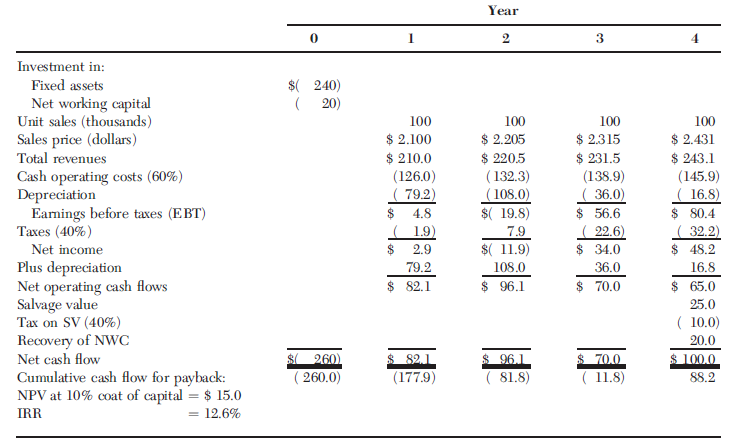Problem 10-16 contained the details of a new-project capital budgeting evaluation being conducted by Unilate Textiles. Although
Question:
a. (1) What are the three levels, or types, of project risk that are normally considered?
(2) Which type of risk is the most relevant?
(3) Which type of risk is the easiest to measure?
(4) How are the three types of risk generally related?
b. (1) What is sensitivity analysis?
(2) Discuss how one would perform a sensitivity analysis on the unit sales, salvage value, and required rate of return for the project. Assume that each of these variables deviates from its base-case, or expected, value by plus and minus 10, 20, and 30 percent. How would you calculate the NPV, IRR, and the payback for each case?
(3) What is the primary weakness of sensitivity analysis? What are its primary advantages?
c. Assume you are confident about the estimates of all the variables that affect the project€™s cash flows except unit sales. If product acceptance is poor, sales would be only 75,000 units a year, whereas a strong consumer response would produce sales of 125,000 units. In either case, cash costs would still amount to 60 percent of revenues. You believe that there is a 25 percent chance of poor acceptance, a 25 percent chance of excellent acceptance, and a 50 percent chance of average acceptance (the base case).

(1) What is the worst-case NPV? The best-case NPV?
(2) Use the worst-case, most likely (or base) case, and best-case NPVs and probabilities of occurrence to find the project€™s expected NPV, standard deviation (sNPV), and coefficient of variation (CVNPV).
d. (1) Assume that Unilate€™s average project has a coefficient of variation (CVNPV) in the range of 1.25 to 1.75. Would the silk/wool blend fabric project be classified as high risk, average risk, or low risk? What type of risk is being measured here?
(2) Based on common sense, how highly correlated do you think the project would be to the firm€™s other assets? (Give a correlation coefficient, or range of coefficients, based on your judgment.)
(3) How would this correlation coefficient and the previously calculated s combine to affect the project€™s contribution to corporate, or withinfirm, risk? Explain.
e. (1) Based on your judgment, what do you think the project€™s correlation coefficient would be with respect to the general economy and thus
with returns on €˜€˜the market€™€™?
(2) How would correlation with the economy affect the project€™s market risk?
f. (1) Unilate typically adds or subtracts 3 percentage points to the overall required rate of return to adjust for risk. Should the project be accepted?
(2) What subjective risk factors should be considered before the final decision is made?
g. Define scenario analysis and simulation analysis, and discuss their principal advantages and disadvantages. (Note that you have already done scenario analysis in part c.)
h. (1) Assume that the risk-free rate is 10 percent, the market risk premium is 6 percent, and the new project€™s beta is 1.2. What is the project€™s required rate of return on equity based on the CAPM?
(2) How does the project€™s market risk compare with the firm€™s overall market risk?
(3) How does the project€™s stand-alone risk compare with that of the firm€™s average project?
(4) Briefly describe how you could estimate the project€™s beta. How feasible do you think that procedure actually would be in this case?
(5) What are the advantages and disadvantages of focusing on a project€™s market risk?
In problem 10-16
Unilate Textiles is evaluating a new product, a silk/wool blended fabric. Assume you were recently hired as assistant to the director of capital budgeting, and you must evaluate the new project. The fabric would be produced in an unused building adjacent to Unilate€™s Southern Pines, North Carolina plant. Unilate owns the building, which is fully depreciated. The required equipment would cost $200,000, plus an additional $40,000 for shipping and installation. In addition, inventories would rise by $25,000, and accounts payable would go up by $5,000. All of these costs would be incurred at Year 0. By a special ruling, the machinery could be depreciated under the MACRS system as 3-year class property. (See Table 10A-2 at the end of this chapter for MACRS recovery allowance percentages.) The project is expected to operate for four years, at which time it will be terminated. The cash inflows are assumed to begin one year after the project is undertaken, or at t = 1, and to continue out to t = 4. At the end of the project€™s life (Year 4), the equipment is expected to have a salvage value of $25,000. Unit sales are expected to total 100,000 five-yard textile rolls per year, and the expected sales price is $2 per roll. Cash operating costs for the project (total operating costs excluding depreciation) are expected to total 60 percent of dollar sales. Unilate€™s marginal tax rate is 40 percent, and its required rate of return is 10 percent. Tentatively, the silk/wool blend fabric project is assumed to be of equal risk to Unilate€™s other assets. You have been asked to evaluate the project and to make a recommendation as to whether it should be accepted or rejected. To guide you in your, your boss gave you the following set of tasks to complete:
Accounts payable (AP) are bills to be paid as part of the normal course of business.This is a standard accounting term, one of the most common liabilities, which normally appears in the balance sheet listing of liabilities. Businesses receive... Capital Budgeting
Capital budgeting is a practice or method of analyzing investment decisions in capital expenditure, which is incurred at a point of time but benefits are yielded in future usually after one year or more, and incurred to obtain or improve the...
Step by Step Answer:

Essentials of Managerial Finance
ISBN: 978-0324422702
14th edition
Authors: Scott Besley, Eugene F. Brigham





